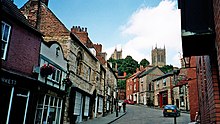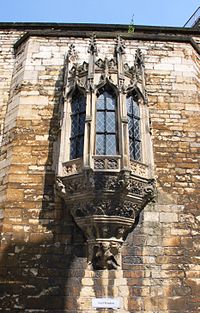Welcome to Visit Lincoln, England Places
The Walkfo guide to things to do & explore in Lincoln, England
![]() Visit Lincoln, England places using Walkfo for free guided tours of the best Lincoln, England places to visit. A unique way to experience Lincoln, England’s places, Walkfo allows you to explore Lincoln, England as you would a museum or art gallery with audio guides.
Visit Lincoln, England places using Walkfo for free guided tours of the best Lincoln, England places to visit. A unique way to experience Lincoln, England’s places, Walkfo allows you to explore Lincoln, England as you would a museum or art gallery with audio guides.
Visiting Lincoln, England Walkfo Preview
Lincoln is a cathedral city and county town of Lincolnshire. The non-metropolitan district of Lincoln had a 2012 population of 94,600. The 2011 census gave the urban area of Lincoln, including North Hykeham and Waddington, a population of 115,000. When you visit Lincoln, England, Walkfo brings Lincoln, England places to life as you travel by foot, bike, bus or car with a mobile phone & headphones.
Lincoln, England Places Overview: History, Culture & Facts about Lincoln, England
Visit Lincoln, England – Walkfo’s stats for the places to visit
With 88 audio plaques & Lincoln, England places for you to explore in the Lincoln, England area, Walkfo is the world’s largest heritage & history digital plaque provider. The AI continually learns & refines facts about the best Lincoln, England places to visit from travel & tourism authorities (like Wikipedia), converting history into an interactive audio experience.
Lincoln, England history
Earliest history: Lincoln

The earliest origins of Lincoln can be traced to remains of an Iron Age settlement of round wooden dwellings. It was built by a deep pool in the River Witham at the foot of a large hill, on which the Normans later built Lincoln Cathedral and Lincoln Castle. The extent of the original settlement is unknown, as its remains are buried beneath the later Roman and medieval ruins and modern Lincoln.
Roman history: Lindum Colonia

The Romans conquered this part of Britain in 48 CE and soon built a legionary fortress. Celtic Lindon was later Latinised to Lindum and the title Colonia added when it became settled by army veterans. The conversion to a colonia occurred when the legion moved on to York (Eboracum) in 71 CE.
AD 410–1066

Germanic tribes from the North Sea area settled Lincolnshire in the 5th–6th centuries. The Latin Lindum Colonia shrank in Old English to Lindocolina, then to Lincylene. After establishment of the Danelaw in 886, Lincoln became one of the Five East Midland Boroughs.
Cathedral

Lincoln Cathedral was completed in 1092 and rebuilt after a fire, but succumbed to an earthquake in 1185. Its crossing tower was crowned by a spire reputedly Europe’s highest at 525 ft (160 m) When complete, the central spire is widely accepted to have succeeded the Great Pyramids of Egypt as world’s tallest man-made structure.
Medieval town

In 1141 Lincoln was the site of a battle between King Stephen and the forces of Empress Matilda, led by her illegitimate half-brother Robert, 1st Earl of Gloucester. Lincoln weavers had set up a guild in 1130 to produce Lincoln Cloth, especially the fine dyed “scarlet” and “green” Cloth was later enhanced by the legendary Robin Hood wearing woollens of Lincoln green.
16th century

The Dissolution of the Monasteries cut Lincoln’s main source of diocesan income. Seven monasteries closed in the city alone, as did several nearby abbeys. A symbol of Lincoln’s decline came in 1549, when the cathedral’s great spire collapsed.
Civil War

Lincoln was on a frontier between the Royalist and Parliamentary forces during the English Civil War. Lincoln now had no major industry and no easy access to the sea. It suffered as the rest of the country was beginning to prosper in the early 18th century.
Georgian age
By the Georgian era, Lincoln’s fortunes began to pick up thanks to the Agricultural Revolution. Reopening of the Foss Dyke canal eased imports of coal and other raw materials vital to industry. Along with the economic growth of Lincoln in this period, the city boundaries were spread to include the West Common.
Industrial Revolution
Lincoln began to excel in heavy engineering, by building locomotives, steam shovels and all manner of heavy machinery. Coupled with the arrival of railway links, Lincoln boomed again during the Industrial Revolution. A permanent military presence came with the “Old Barracks” (now held by the Museum of Lincolnshire Life)
20th century

Lincoln was hit by typhoid in 1904 – 1905 caused by polluted drinking water from Hartsholme Lake and the River Witham. Over 1,000 people contracted the disease and fatalities totalled 113, including the man responsible for the city’s water supply, Liam Kirk of Baker Crescent. Lincoln’s chlorination episode was an early use of chlorine to disinfect a water supply.
Lincoln, England economy & business
Retail parks
Lincoln has a choice of seven large national supermarkets (Tesco, Asda, Sainsbury, Waitrose, Morrisons, Aldi and Lidl) St Mark’s Square complex had a Debenhams as its flagship store until 2021.
Tourism

Lincolnshire is a tourist centre for visitors to historic buildings that include the cathedral, the castle and the medieval Bishop’s Palace. The Collection, of which the Usher Gallery is now part, is an important attraction, partly in a purpose-built venue. Other attractions include the Museum of Lincolnshire Life and the International Bomber Command Centre.
Why visit Lincoln, England with Walkfo Travel Guide App?
![]() You can visit Lincoln, England places with Walkfo Lincoln, England to hear history at Lincoln, England’s places whilst walking around using the free digital tour app. Walkfo Lincoln, England has 88 places to visit in our interactive Lincoln, England map, with amazing history, culture & travel facts you can explore the same way you would at a museum or art gallery with information audio headset. With Walkfo, you can travel by foot, bike or bus throughout Lincoln, England, being in the moment, without digital distraction or limits to a specific walking route. Our historic audio walks, National Trust interactive audio experiences, digital tour guides for English Heritage locations are available at Lincoln, England places, with a AI tour guide to help you get the best from a visit to Lincoln, England & the surrounding areas.
You can visit Lincoln, England places with Walkfo Lincoln, England to hear history at Lincoln, England’s places whilst walking around using the free digital tour app. Walkfo Lincoln, England has 88 places to visit in our interactive Lincoln, England map, with amazing history, culture & travel facts you can explore the same way you would at a museum or art gallery with information audio headset. With Walkfo, you can travel by foot, bike or bus throughout Lincoln, England, being in the moment, without digital distraction or limits to a specific walking route. Our historic audio walks, National Trust interactive audio experiences, digital tour guides for English Heritage locations are available at Lincoln, England places, with a AI tour guide to help you get the best from a visit to Lincoln, England & the surrounding areas.
“Curated content for millions of locations across the UK, with 88 audio facts unique to Lincoln, England places in an interactive Lincoln, England map you can explore.”
Walkfo: Visit Lincoln, England Places Map
88 tourist, history, culture & geography spots
Lincoln, England historic spots | Lincoln, England tourist destinations | Lincoln, England plaques | Lincoln, England geographic features |
| Walkfo Lincoln, England tourism map key: places to see & visit like National Trust sites, Blue Plaques, English Heritage locations & top tourist destinations in Lincoln, England | |||
Best Lincoln, England places to visit
Lincoln, England has places to explore by foot, bike or bus. Below are a selection of the varied Lincoln, England’s destinations you can visit with additional content available at the Walkfo Lincoln, England’s information audio spots:

Sobraon Barracks
Sobraon Barracks is a military installation in Lincoln, England . It is currently occupied by the 160 (Lincoln) Squadron Royal Logistic Corps and Lincolnshire Army Cadet Force .

Canwick
Canwick is a village and civil parish in the North Kesteven district of Lincolnshire. The population of the civil parish at the 2011 census was 324. It is situated 1 mile (1.6 km) south from the city and county town of Lincoln.

Hospital of the Holy Innocents
The Hospital of the Holy Innocents, or the Melandry, was a Leper Hospital on South Park common in Lincoln, England. It was possibly the first to be founded in England. The Hospital was founded in the late 11th or early 12th century.

The Old Deanery, Lincoln
The Old Deanery, Lincoln was the official residence of the Dean of Lincoln. The Deanery is thought to have been started in 1254 by Richard de Gravesend. The great kitchen, the buttery and other offices stood in the same range of buildings. They were extensively damaged during the English Civil War and rebuilt after 1660.

John O’Gaunts
John O’Gaunts was a football ground in Lincoln in England. It was the home ground of Lincoln City from 1884 until 1895. Lincoln City were home to Lincoln City between 1884 and 1895.

St Andrew’s Church, Lincoln
St. Andrew’s Church, Lincoln was a parish church on Canwick Road in Lincoln in the Church of England between 1877 and 1968.

St Peter at Gowts
St Peter at Gowts is a Grade I listed parish church in Lincoln, England. It is located in Gowts, Lincoln, and is situated on the outskirts of the city.

St. Catherine’s Priory, Lincoln
St. Katherine’s Priory also known as The Priory of Saint Katherine without Lincoln was a Gilbertine priory of Canons Regular. It ran the Hospital of St Sepulchre, probably the first hospital in the city.

St Mary’s Guildhall, Lincoln
St Mary’s Guildhall is a major domestic complex, indicating the highest social status, built in the medieval city of Lincoln, England, known as Wigford. The Guildhall faces directly onto Lincoln High Street and stands to the north of Sibthorp Street.

John of Gaunt’s Palace, Lincoln
John of Gaunt’s Palace was a late 14th-century merchant’s house. It was progressively demolished from the late 18th century until the 1960s. The very fine oriel window from the building has been preserved in the gatehouse of Lincoln Castle.
Visit Lincoln, England plaques
![]() 24
24
plaques
here Lincoln, England has 24 physical plaques in tourist plaque schemes for you to explore via Walkfo Lincoln, England plaques audio map when visiting. Plaques like National Heritage’s “Blue Plaques” provide visual geo-markers to highlight points-of-interest at the places where they happened – and Walkfo’s AI has researched additional, deeper content when you visit Lincoln, England using the app. Experience the history of a location when Walkfo local tourist guide app triggers audio close to each Lincoln, England plaque. Explore Plaques & History has a complete list of Hartlepool’s plaques & Hartlepool history plaque map.